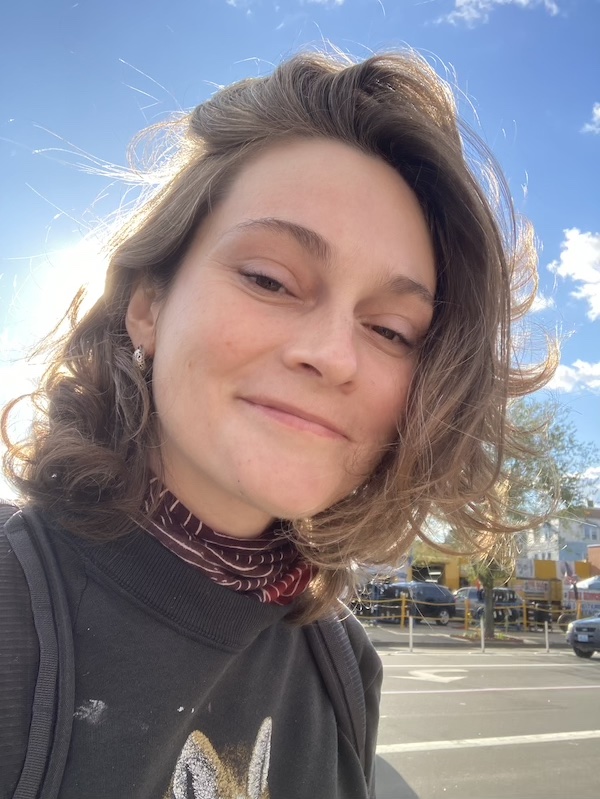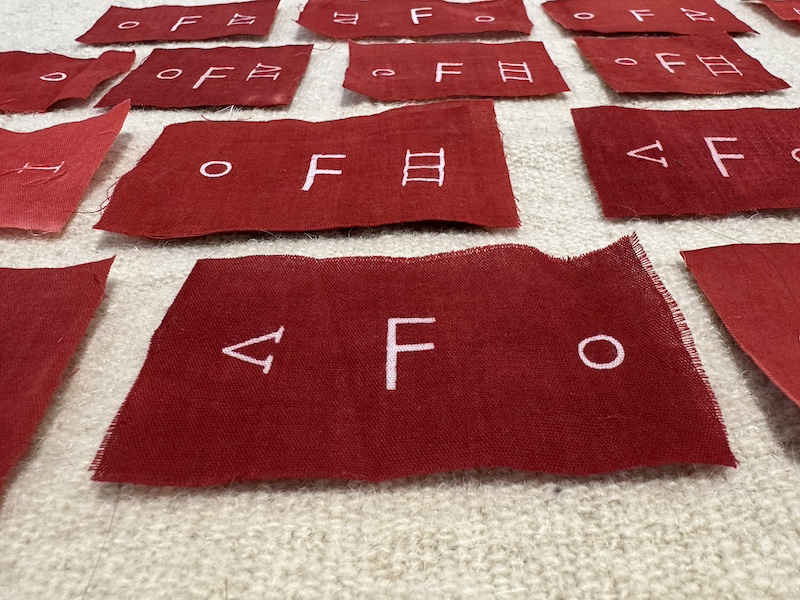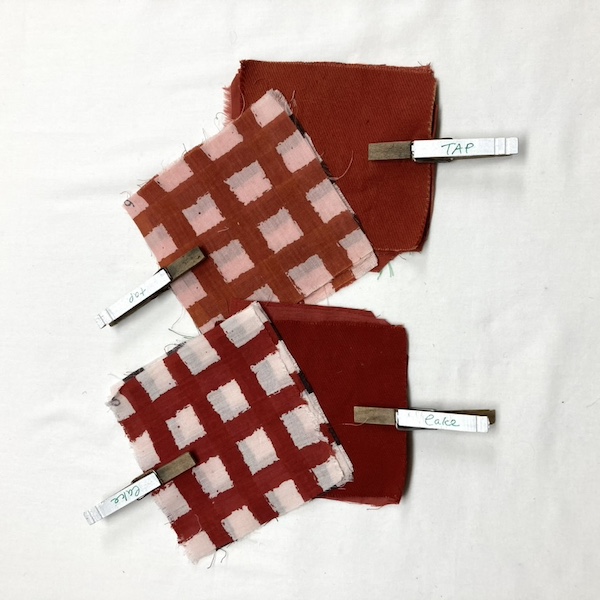
For this week’s Sunday Visit, we catch up with textile artist, researcher, and natural dyer, Madeleine McGarrity of Cold N’ Deadly.
Madeleine McGarrity is a designer, textile researcher, and professional printmaker currently living and working in Providence, RI. She grew up in rural Northwest New Jersey, graduated from Rhode Island School of Design with a BFA in Printmaking in 2010, and worked as a teacher and professional textile printer in Brooklyn, NY from 2012 to 2020. In 2019, she started Cold and Deadly, a project investigating the development of a modern system for textile printing with natural dyes. She is passionate about textile history, watershed ecology, and circular production methods.
We first discovered Madeleine in 2020 and had her on FEEDBACK FRIDAY (Water Madders) with researcher and natural dyer Jamie Bourgeois talking madder and water quality. It was a wake up call in many ways.
The discussion focused on the duos investigations into water quality using madder from Rubia tinctorum to better understand the composition of a selection of water sources. At the time, Jamie was concentrating on the possible presence of toxic contaminants taken from Louisiana’s Cancer Alley, a 150-mile stretch of the Mississippi River infamous for both pollution levels and cancer rates. Madeleine was and still is, focusing on the impact of water composition on print quality and clarity printing textile yardage with natural dyes.
We caught up with Madeleine to see how her research is going.

Your textile printing with natural dyes is so amazing. Can you talk more about how you made it your focus?
Thank you! Plants and the natural world have always been a point of interest for me, as has frustration over the realities of both man-made climate change and the destruction of ecosystems by capitalist interests. Working in the textile sector in New York City for ten years woke me up to the waste that occurs in the fashion industry at large–outside of the small production shop I worked in–and to how few truly sustainable options there are for small-scale printers.
I’d just begun exploring natural dye when I developed a repetitive stress injury, resulting in a long break from both my personal and professional work. I was only just getting started again when the pandemic hit.
The interest was still there, but my results were just as dismal as I remembered. My progress was inhibited by the bounds of my own knowledge and experience, but the limitations of lockdown provided ample space to begin research and small-scale testing. I wanted a way to target specific outcomes with natural dyes, rather than subject myself to the whims of my materials. It was really hard! But I was already used to the extensive, sometimes days-long process of planning, intention, and repetition required in all printmaking processes. The long, detailed testing it would take to learn how to get reliable results printing with natural dyes felt immediately familiar. It also helps that I love to read and am very interested in history, which makes my research particularly satisfying.
I chose screen printing instead of a more historically accurate printing process, for its flexibility and speed, because I’m so familiar with it professionally, and because it is the most common modern process for printing textile yardage. I chose plaids because they are a neutral, well known pattern, and offer even, unbiased feedback on backgrounds, solids and overlays. Distressing the edges of the stripes in the plaid creates an additional opportunity to gather detailed information on “ink” printability. Just as importantly, plaids are also not part of the visual language in my personal work, and thus free from subjective color preference.
Once I started testing and investigating these processes, I became more invested, the project grew, and became what I spend the majority of my time on. Recently, I’ve also started to spare some focus for my personal art work again, which has been extremely rewarding.

The work you do with water and how it impacts color has fascinated us here at Botanical Colors for years. What has been the most interesting water you’ve worked with and why?
I should mention a few, because I’ll usually say the most interesting water I’ve worked with is whatever I’m testing currently, but there are so many other bright spots in my past testing. Right now, the water in Providence, specifically at the RISD Textile Department, is producing superior but unexpected results, some of which can be seen publicly on my Instagram page. I’ve been getting a clarity in background better than I have ever gotten from tap water, as well as a richness of tone that the control samples themselves lacked.
The most frustrating water I’ve worked with thus far has been from the lake I recently lived on in New Jersey. Using a natural source for my testing allowed me to track how much the quality of a local body of water can fluctuate throughout the year. Road salt runoff, herbicide/pesticide use, motorized vehicle use, and the temperature of the lake all seem to impact the outcomes of my tests, so much so that I reverted to rain water use only, which slowed my progress. It also inspired me to participate in a road salt testing and data collection program run by a non-profit. A lot of states have an organization doing this type of work; if you live by a body of water in a state that gets snow, I would encourage you to participate if you can.
Creating or locating better water for dying is always of great interest to me. Using rain water exclusively has forced me to use less water, which is good in so many ways, but it also had an impact on my tests, especially as they increased in scale. The relationship of volume-to-outcome is something I’m very interested in exploring further.

How do you see all your research benefiting the natural dye community?
Natural dyeing seems to be reaching a wider audience every day. I think that’s great. I see a future of natural dye reintegrated into textile and garment production–but at a sustainable scale. The system I’m working on is intended to be used for small scale production, with the hope that it could be integrated into a future local economy of fiber producers, industrial mills and artisans, offering an alternative to the current globalized large-scale production that is dominating our markets, shredding our planetary ecosystems, and destroying the quality of life of people all over the world.
On a smaller scale, I’d like to offer more frequent classes soon, and also attend more myself. It’s good practice to remember that many of our cohort support themselves with their dye work and taking classes with them is an ethical way to learn from them. I approached textiles professionally from a non-textile background, and thus much of my understanding is frustratingly either very niche or very general depending on the topic. Research has widened my knowledge, but I’d love to experience first-hand the realities of the rest of the textile universe, such as fiber processing and weaving, and to learn those techniques from experts in the field. I think there’s a middle ground between serious, guarded focus on your own work and actively taking part in a community that wants to push towards a better future; it’s a hard sweet-spot to find, but I think it’s something we should all be looking for together.
What’s a color you’re really drawn to right now and why?
Most people expect me to say madder red, I think, but I’m very excited to move onto other colors! Cochineal, with its deep blue-leaning pinks and crimson tones, is an imperative addition to a natural dye system that provides a decent color range. Cochineal and madder marry so well on silk and wool, and I’m eager to see how they could come together in print. I have some particular ideas of how to approach this dyestuff, and I can’t wait to try them out!
I also really love the buckthorn testing I’ve done thus far and can’t wait to see more. It yields a warm, bright yellow (also a necessary part of a mixing system) with alum and a sophisticated olive green with iron.
With the addition of these two colors, I’m that much closer to a full tonal range. As I move on to different dyes, I intend to start testing dye combinations together, which is technically complex in the mordant printing system and something I’ve been working towards for a long time.

Follow Madeleine’s work on Instagram!!
Shop:
